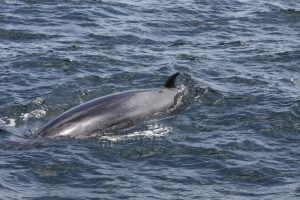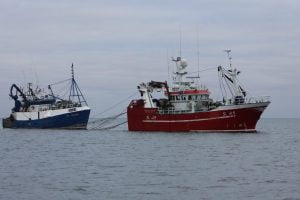
After one of the wettest and stormiest winters of all time, the sea has finally settled down, and clarity has returned to the water, from being a thick sedimentary soup for the past four months. Huge waves and giant swell create a churning effect on all the fine sediment on the sea bed, both inshore and offshore. With vast amounts of mud, sewage and slurry added to it from the swollen rivers, streams and general flooding of the land, it really has been a primordial soup over the winter.
The clearing of the water has an immediate effect on all the marine wildlife. Sand eels, sprats and herrings begin to assemble into shoals, after spending the winter in small fragmented groups, unable to stay together in murky, clouded seawater. These shoals attract the attentions of thousands of shearwaters, hundreds of gannets and kittiwakes, enormous numbers of guillemots and razorbills, and, not least of all, whales and dolphins.
Recent observations at sea demonstrate this fact very well. The water is now full of organic nutrients. Add some strong sunshine and the tiny plants of the oceans, phytoplankton, develop rapidly, consuming these nutrients, colouring the sea into a green soup. This in turn triggers the zoo-plankton, billions of tiny creatures, that feed on phytoplankton. The marine food chain is thus “kick-started”. The zoo-plankton is gorged upon by sand eels, sprats, herrings and mackerel, hungry from surviving the winters deprivations, and suddenly all manner of predators arrive to feed on these shoaling fish.
Based on more than forty years of observation, I would predict that there is going to be an intense plankton bloom this year, and thus, an abundance of everything else, right up to and including the predators at the top of the food chain; whales and dolphins. This is of course assuming we have some kind of sensible spring weather, involving plenty of sunshine and a resulting warming of the water. These conditions should produce a good showing of basking sharks, which consume nothing but zoo-plankton. There are already a few of them showing up on the west coast, and it’s still early days for these huge fish. How such a large shark evolved to become a plankton feeder is something of a mystery, as is where they go in winter and where in the oceans their breeding activity takes place.

Whilst fishing in West Cork in the mid 1970s, we caught a very large specimen in our nets. Unable to free it from our gear, we towed it into the harbour and grounded it to recover the nets. It was, for me, a wonderful opportunity to examine one of these giants. I was astonished to discover it had large triangular teeth, like any other flesh eating species, but buried in slots within its gums, so as to be totally ineffective. It is worth mentioning that the basking shark is a very close relative of the much maligned Great white shark. But basking sharks cannot bite and make no attempt to do so, even when in difficulty. Their only defence against attack or unwelcome attention is their super-abrasive, thorny skin, coated with thick blue-black slime. Do not grab hold of one, you’ll have sore skin for several days after.
It is a delight to find that there are minke whales about in numbers already. It’s still early in the season for them, and it’s even more remarkable that most years we can expect to find them in local West Cork waters right up to Christmas! The signs are all there for a good season of whale watching. As usual it’s all up to what our erratic climate decides to do next.
Colin Barnes
Skipper MV Holly Jo

